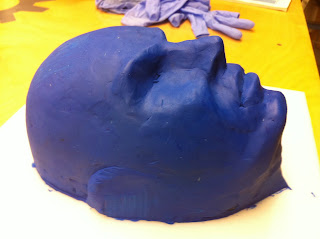This time, I post of adventure with my new Harbor Freight 2.5 gallon pressure chamber which I bought for $98.
It's a poorly constructed affair, with iffy mounts and cheap metal... but it's solid enough to work with and should serve until a better one come available.
This one won't yet sit at 60psi with the hard, badly seated seal that sits there now, but it does well at 40-45psi. As one requires a minimum of around 40psi for decent castings... I am sure this can be improved with a few dollars here and there.
Below is a series of photos showing the mold, which was made with a small Bel-Art vacuum degassing chamber i borrowed for my friend Earl Powell.
This mold used "Smooth-On" Oomoo-30 tin silicone... and I used this carpet tape and modeling clay to seat the parts. The chamber walls are simple scrap polyethylene taped together.
The results are VERY good, the vacuum chamber yielded smooooooth tight molds with excellent detail and almost bubble free finish. I suspect the vacuum PUMP was to blame for the few bubbles, it was a borrowed one from the TechShop donated tool room and looked... tired.
These are a few casings WITHOUT the pressure chamber, as you can see, nice... but up close, the bubbles are clearly seen.
And here's the WASTED castings, the many attempts to get a good one DROVE to buying the pressure chamber!
Yuck!
Now... here are the castings WITH the pressure chamber:
Very sharp! Even with me having inject the mold (syringe), Carry the mold to the chamber, crank the wing nuts by hand and and pressurize all in four minutes.
Here we can see the clear plastic is EVEN CLEARER, which means I can actually consider clear plastic as a casting option.
Still the yield was relatively low for a full days casting, and now I see why casters ask SO MUCH for certain jobs.
The clarity and functionality of this process is undeniable and I have been a fool for not breaking down and buying a tank sooner... though I probably still would need a nice compressor if it weren't for TechShops equipment.




































